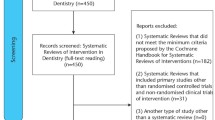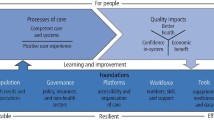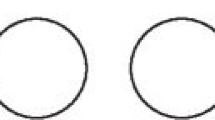Abstract
Introduction The COVID-19 pandemic has urged healthcare systems to develop new ways to safely provide care. Telehealth has become a compelling alternative. Our purpose was to evaluate the accuracy and effectiveness of teledentistry for screening, diagnosis and therapeutic management of dental care in children and adults.
Methods We conducted a systematic review (SR) of systematic reviews. Multiple databases, the grey literature and conference archives were searched. Eligible SRs included those reporting virtual screening, diagnostic investigations and therapeutic interventions. Two investigators independently reviewed abstracts, articles, critically appraised SRs and extracted the data.
Results We identified 817 citations and included six SRs. The accepted SRs involved >7,000 participants, used primarily asynchronous communication for diagnostic/screening outcomes and used synchronous communication for treatment outcomes. SRs were of low quality and included 30 primary studies of our interest. Sensitivity and specificity for dental referrals and diagnostic treatment planning were higher than other index/reference tests, ranging from 80-88% and 73-95%, respectively. Treatment outcome measured patient compliance and professional supervision.
Conclusion This SR provides the best existing evidence for clinical decision-making involving teledentistry. Current evidence supports teledentistry as an effective means for dental referrals, treatment planning and compliance and treatment viability. Asynchronous communication and the adoption of smartphones for image capturing are feasible and convenient for the implementation of teledentistry.
This is a preview of subscription content, access via your institution
Access options
Subscribe to this journal
Receive 4 print issues and online access
$259.00 per year
only $64.75 per issue
Buy this article
- Purchase on SpringerLink
- Instant access to full article PDF
Prices may be subject to local taxes which are calculated during checkout

Similar content being viewed by others
References
Shigekawa E, Fix M, Corbett G, Roby D H, Coffman J. The Current State Of Telehealth Evidence: A Rapid Review. Health Aff (Millwood) 2018; 37: 1975-1982.
Hollander J E, Carr B G. Virtually perfect? Telemedicine for Covid-19. N Engl J Med 2020; 382: 1679-1681.
Royal College of Dental Surgeons of Ontario. COVID-19: Guidance for the Use of Teledentistry. 2020. Available at https://www.rcdso.org/en-ca/rcdso-members/2019-novel-coronavirus/covid-19---emergency-screening-of-dental-patients-using-teledentistry (accessed May 2022).
Nichols K R. Teledentistry Overview: United States of America. J Int Soc Telemed eHealth 2019; 7: 1-6.
American Dental Association. ADA Policy on Teledentistry. 2020. Available at https://www.ada.org/about/governance/current-policies/ada-policy-on-teledentistry#:~:text=Coverage%20for%20services%20delivered%20via,health%20care%20provider%20is%20licensed (accessed May 2022).
Oral Helath Workforce Research Center. Case Studies of 6 Teledentistry Programs: Strategies to Increase Access to General and Speciality Dental Services. 2016. Available at https://oralhealthworkforce.org/wp-content/uploads/2017/02/OHWRC_Case_Studies_of_6_Teledentistry_Programs_2016.pdf (accessed May 2022).
Correia A D da M S, Dobashi B F, Gonçalves C C M et al. Teleodontologia no programa nacional telessaúde Brasil redes: relato da experiência em Mato Grosso Do Sul. Rev da ABENO 2014; 14: 17-29.
Estai M, Kanagasingam Y, Tennant M, Bunt S. A systematic review of the research evidence for the benefits of teledentistry. J Telemed Telecare 2018; 24: 147-156.
Alabdullah J H, Daniel S J. A Systematic Review on the Validity of Teledentistry. Telemed J E Health 2018; 24: 639-648.
Irving M, Stewart R, Spallek H, Blinkhorn A. Using teledentistry in clinical practice as an enabler to improve access to clinical care: A qualitative systematic review. J Telemed Telecare 2018; 24: 129-146.
Moher D, Liberati A, Tetzlaff J, Altman D G, PRISMA Group. Preferred reporting items for systematic reviews and meta-analyses: The PRISMA statement. PLoS Med 2009; DOI: 10.1371/journal.pmed.1000097.
Shea B J, Reeves B C, Wells G et al. AMSTAR 2: a critical appraisal tool for systematic reviews that include randomised or non-randomised studies of healthcare interventions, or both. BMJ 2017; DOI: 10.1136/bmj.j4008.
Cinquini M, Moschetti I, Minozzi S. Assessing the methodological quality of systematic review: the AMSTAR II-DTA extension. Cochrane Database Syst Rev 2020; DOI: 10.1002/14651858.CD201901.
Daniel S J, Wu L, Kumar S. Teledentistry: A systematic review of clinical outcomes, utilization and costs. J Dent Hyg 2013; 87: 345-352.
Flores A P da C, Lazaro S A, Molina-Bastos C G et al. Teledentistry in the diagnosis of oral lesions: A systematic review of the literature. J Am Med Inform Assoc 2020; 27: 1166-1172.
Troconis C M, Ribón J R, Puello P. Impact of Teledentistry Programs on Dental Service in Rural Areas: A Systematic Review. Int J Appl Eng Res 2018; 13: 14417-14423.
Fortich-Mesa N, Hoyos-Hoyos V. Applications of teledentistry in dental practice: a systematic review. Rev Fac Odontol Univ Antioq 2020; 32: 77-88.
Estai M, Kanagasingam Y, Huang B et al. The efficacy of remote screening for dental caries by mid-level dental providers using a mobile teledentistry model. Community Dent Oral Epidemiol 2016; 44: 435-441.
Morosini I D A C, de Oliveira D C, Ferreira F D M, Fraiz F C, Torres-Pereira C C. Performance of distant diagnosis of dental caries by teledentistry in juvenile offenders. Telemed J E Health 2014; 20: 584-589.
Kopycka-Kedzierawski D T, Billings R J, McConnochie K M. Dental screening of preschool children using teledentistry: a feasibility study. Paediatr Dent 2007; 29: 209-213.
Amavel R, Cruz-Correia R, Frias-Bulhosa J. Remote diagnosis of children dental problems based on non-invasive photographs - a valid proceeding? Stud Health Technol Inform 2009; 150: 458-462.
Namakian M, Subar P, Glassman P, Quade R, Harrington M. In-person versus '"virtual"' dental examination: congruence between decision-making modalities. J Calif Dent Assoc 2012; 40: 587-595.
Berndt J, Leone P, King G. Using teledentistry to provide interceptive orthodontic services to disadvantaged children. Am J Orthod Dentofac Orthop 2008; 134: 700-706.
McLaren S W, Kopycka-Kedzierawski D T. Compliance with dental treatment recommendations by rural paediatric patients after a live-video teledentistry consultation: A preliminary report. J Telemed Telecare 2016; 22: 198-202.
Green J I. An Overview of the Peer Assessment Rating (Par) Index for Primary Dental Care Practitioners. Prim Dent J 2016; 5: 28-37.
Smith V, Devane D, Begley C M, Clarke M. Methodology in conducting a systematic review of systematic reviews of healthcare interventions. BMC Med Res Methodol 2011; DOI: 10.1186/1471-2288-11-15.
Jacobs M J E, Edmondson M J, Lowry J C. Accuracy of diagnosis of fractures by maxillofacial and accident and emergency doctors using plain radiography compared with a telemedicine system: a prospective study. Br J Oral Maxillofac Surg 2002; 40: 156-162.
Mandall N A, O'Brien K D, Brady J, Worthington H V, Harvey L. Teledentistry for screening new patient orthodontic referrals. Part 1: A randomised controlled trial. Br Dent J 2005; 199: 659-662.
Brüllmann D, Schmidtmann I, Warzecha K, D'Hoedt B. Recognition of root canal orifices at a distance - a preliminary study of teledentistry. J Telemed Telecare 2011; 17: 154-157.
Purohit B M, Singh A, Dwivedi A. Utilization of teledentistry as a tool to screen for dental caries among 12-year-old school children in a rural region of India. J Public Health Dent 2017; 77: 174-180.
Pentapati K-C, Siddiq H. Clinical applications of intraoral camera to increase patient compliance - current perspectives. Clin Cosmet Investig Dent 2019; 11: 267-278.
Birur P N, Sunny S P, Jena S et al. Mobile health application for remote oral cancer surveillance. J Am Dent Assoc 2015; 146: 886-894.
Fricton J, Chen H. Using teledentistry to improve access to dental care for the underserved. Dent Clin North Am 2009; 53: 537-548.
Bavaresco C S, Hauser L, Haddad A E, Harzheim E. Impact of teleconsultations on the conduct of oral health teams in the Telehealth Brazil Networks Programme. Braz Oral Res 2020; DOI: 10.1590/1807-3107bor-2020.vol34.0011.
Mariño R, Tonmukayakul U, Manton D, Stranieri A, Clarke K. Cost-analysis of teledentistry in residential aged care facilities. J Telemed Telecare 2016; 22: 326-332.
Bradley M, Black P, Noble S, Thompson R, Lamey P J. Application of teledentistry in oral medicine in a Community Dental Service, N. Ireland. Br Dent J 2010; 209: 399-404.
Haddad A E, da Silva D G, Monteiro A, Guedes T, Figueiredo A M. Follow up of the Legislation Advancement Along the Implementation of the Brazilian Telehealth Programme. J Int Soc Telemed eHealth 2016; 4: e11.
Funding
The first author (Nalia Gurge-Juarez) has been supported by an Ontario Graduate Scholarship (OGS). The senior scientific author (Hillel Finestone) received funding from the Faculty of Health Sciences, University of Ottawa.
Author information
Authors and Affiliations
Contributions
Nalia Gurgel-Juarez: contributed to the conception, study design, data acquisition, analysis and interpretation of findings and drafted and critically revised the manuscript. Cassius Torres-Pereira: contributed to the study design, data acquisition and interpretation of findings; supervised the analysis and critically revised the manuscript. Ana E. Haddad: contributed to conception and interpretation of findings and critically revised the manuscript. Lisa Sheehy: contributed to manuscript content and data analysis and critically revised the manuscript. Hillel Finestone: contributed to manuscript content and critically revised the manuscript. Karen Mallet: contributed to manuscript content and critically revised the manuscript. Michael Wiseman: contributed to manuscript content and critically revised the manuscript. Kannika Hour: contributed to data acquisition and analysis. Heather L. Flowers: contributed to study design; supervised the analysis and interpretation of findings; and drafted portions of the manuscript alongside critical revisions. All authors gave their final approval and agreed to be accountable for all aspects of the work.
Corresponding author
Ethics declarations
The authors declare no conflicts of interest.
Rights and permissions
About this article
Cite this article
Gurgel-Juarez, N., Torres-Pereira, C., Haddad, A. et al. Accuracy and effectiveness of teledentistry: a systematic review of systematic reviews. Evid Based Dent (2022). https://doi.org/10.1038/s41432-022-0257-8
Received:
Accepted:
Published:
DOI: https://doi.org/10.1038/s41432-022-0257-8
This article is cited by
-
Teledentistry accuracy for caries diagnosis: a systematic review of in-vivo studies using extra-oral photography methods
BMC Oral Health (2024)
-
Role of teledentistry in enabling improved oral care outcomes
British Dental Journal (2024)
-
Patient satisfaction with e-oral health care in rural and remote settings: a systematic review
Systematic Reviews (2022)



